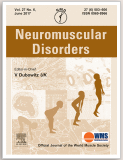 Limb Girdle Muscular Dystrophies (LGMD) and myasthenic syndromes form basically two distinct groups of neuromuscular pathologies. The first result in a more or less progressive deficit of the pelvic and shoulder girdles while the second cause ocular and bulbar symptomatology, with or without fluctuating character. In recent years, numerous observations of abnormalities in postsynaptic transmission in certain forms of LGMD have been made, first in LGMD R19 related to the GMPPB gene and then in other alpha-dystroglycanopathies.
Limb Girdle Muscular Dystrophies (LGMD) and myasthenic syndromes form basically two distinct groups of neuromuscular pathologies. The first result in a more or less progressive deficit of the pelvic and shoulder girdles while the second cause ocular and bulbar symptomatology, with or without fluctuating character. In recent years, numerous observations of abnormalities in postsynaptic transmission in certain forms of LGMD have been made, first in LGMD R19 related to the GMPPB gene and then in other alpha-dystroglycanopathies.
In an article published in January 2020, an American team investigated and characterized neuromuscular transmission defects in a cohort of 31 patients with alpha-dystroglycanopathy, the majority with mutations in the FKRP gene (25/31). The other patients had a mutation in the GMPPB gene (n=4), in the POMGNT1 gene (n=1) or in the POMT2 gene (n=1). Following a targeted clinical examination, an ad hoc questionnaire and an electrophysiological study (EMG), the authors were able to highlight clinical signs suggestive of impaired neuromuscular transmission in 63% of people such as increased fatigue during chewing. On the other hand, if the EMG was disturbed in a patient carrying mutations in the GMPPB gene, this was not the case for patients with mutations in the FKRP gene.
These data may have consequences for the care of the persons concerned since the forms linked to the GMPBB gene often respond well to oral anti-cholinesterases unlike other subtypes of LGMD.
